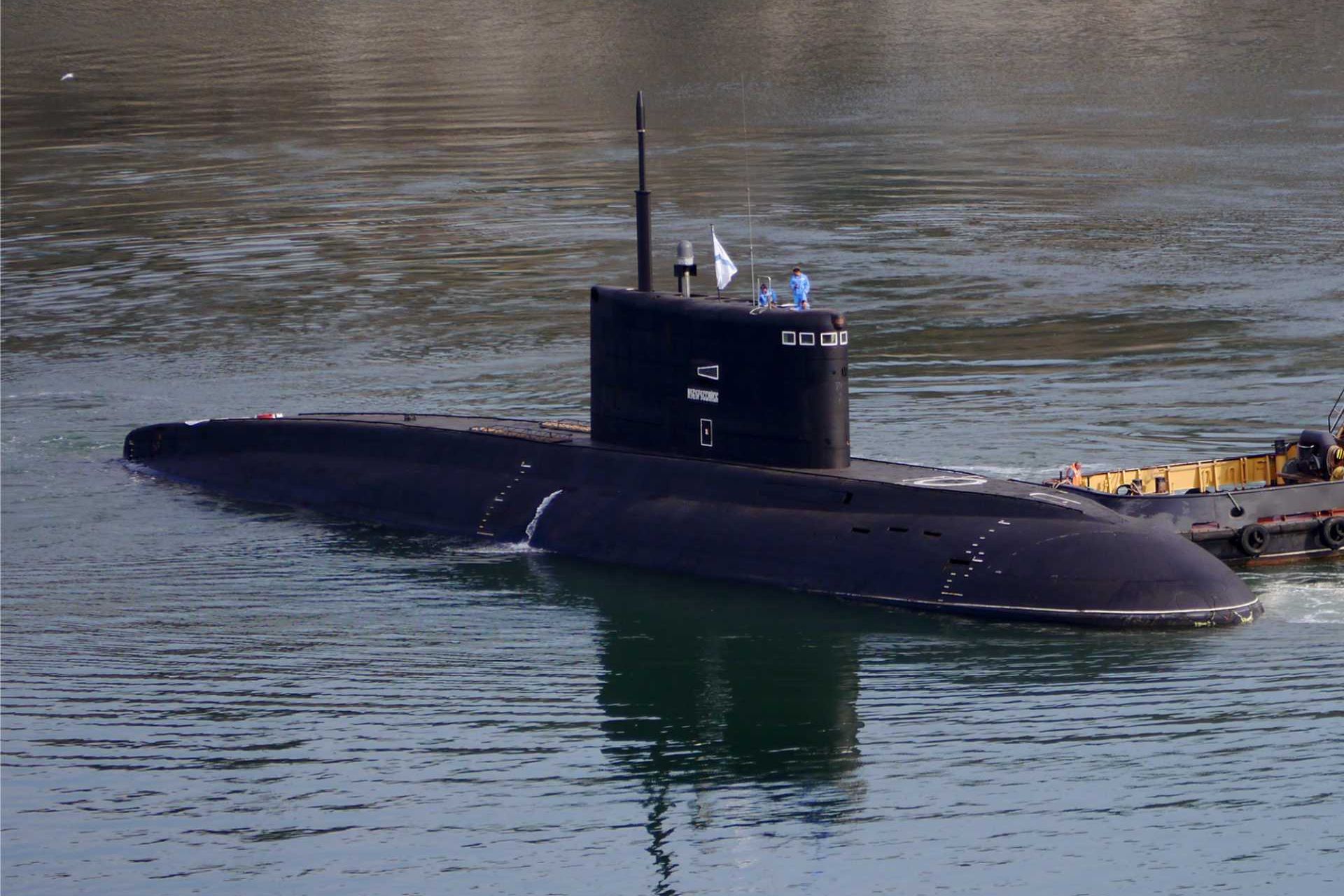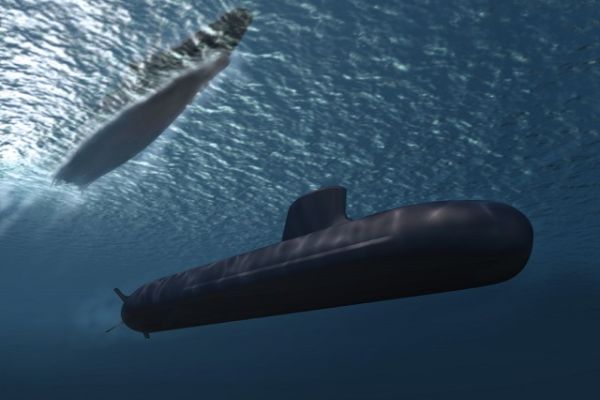Attack submarines.
Improved Kilo-Class Project 636.

The Russian-made Improved Kilo-class is a modernized version of the Kilo-class diesel-electric attack submarines, originally developed by the Soviet Union. The NATO reporting name for this class is Kilo-class, with the original Russian designation being Project 877 "Paltus" (Turbot), and the more advanced version is known as Project 636 in Russia and as the Improved Kilo in the West.
Country users: Algeria, India, Russia
Description
The Russian-made Improved Kilo-class is a modernized version of the Kilo-class diesel-electric attack submarines, originally developed by the Soviet Union. The NATO reporting name for this class is Kilo-class, with the original Russian designation being Project 877 "Paltus" (Turbot), and the more advanced version is known as Project 636 in Russia and as the Improved Kilo in the West. It is part of an upgraded family of vessels that have been in service with the Russian Navy since the early 1990s. Developed as a successor to the original Kilo-class submarine, these submarines were designed with enhanced stealth features, advanced sonar systems, and modern missile capabilities. The Improved Kilo-class comes under the Project 06363 designation in Russia, and these vessels are designed to operate effectively in a wide range of operational environments, particularly in shallow waters where stealth is crucial.
The submarines feature a stealth hull design that incorporates a special rubber anechoic coating to minimize detection by sonar systems. The submarines are equipped with a variety of advanced sonar systems, including the MGK-400EM Rubikon sonar, providing long-range passive and active detection. The sonar systems allow the submarine to detect targets far beyond its own sonar signature, which is crucial for remaining undetected.
The Improved Kilo-class is powered by two 1,500 kW diesel generators and a PG-141M electric motor, which allows for speeds of 19.8 knots submerged and 12 knots surfaced. With a range of up to 7,500 nautical miles when surfaced, and a submerged range of approximately 400 nautical miles, the submarine has a sufficient operational range to perform long-duration missions. Additionally, its ability to dive to a maximum depth of 300 meters ensures it can operate in both shallow coastal waters and deeper oceanic zones.
The Improved Kilo-class has a complement of 60 crew members, including 16 officers, and the vessels are equipped with a comprehensive combat information control system to ensure that the crew can handle complex mission scenarios efficiently.
The B-261 Novorossiysk, launched in 2013 and commissioned in 2014, is one of the most notable Improved Kilo-class submarines currently in service. Other submarines in the class include the B-235 Verkhoturye and B-237 Rostov-on-Don, both of which are in service with the Russian Navy’s Black Sea Fleet.
List of current Improved Kilo-class submarines with hull number:
- B-871 Alrosa – Commissioned in 1990, serving in the Black Sea Fleet.
- B-235 Verkhoturye – Commissioned in 1995, serving in the Pacific Fleet.
- B-237 Rostov-on-Don – Commissioned in 2014, part of the Black Sea Fleet.
- B-261 Novorossiysk – Commissioned in 2014, operating with the Black Sea Fleet.
- B-262 Krasnodar – Commissioned in 2015, part of the Black Sea Fleet.
- B-273 Magadan – Commissioned in 2016, operating with the Russian Pacific Fleet.
- B-275 Petropavlovsk-Kamchatsky – Commissioned in 2020, operating in the Pacific Fleet.
Improved Kilo-Class Type 636 variants:
- Project 636.1: A less advanced version of the 636.3, Russia's Black Sea Fleet primarily uses this variant. It shares many characteristics with the 636.3 but lacks some of the modern upgrades in electronics and propulsion systems. Still, it retains the ability to launch Kalibr missiles and is designed for both anti-submarine and anti-surface warfare, though it has slightly less advanced sonar and stealth capabilities.
- Project 636.3 (Improved Kilo-class): This is the most advanced variant of the Kilo-class, significantly improving on stealth, sensor systems, and firepower. It features the ability to launch Kalibr-PL cruise missiles (anti-ship, land-attack, and anti-submarine) and is equipped with an upgraded MGK-400EM sonar suite, offering superior quietness and detection range. This variant is used by Russia and exported to countries like Vietnam and Algeria. It is specifically designed for increased operational versatility and stealth capabilities.
Technical Data
-
Design
The Improved Kilo-class submarines are designed with a focus on stealth, endurance, and versatility. They are 73.8 meters long, with a beam of 9.9 meters and a draught of 6.6 meters, giving them a compact yet capable design. Their hull is coated with a special rubber anechoic coating, which reduces the sonar signature and enhances the stealth features of the vessel, making them extremely difficult to detect.
These submarines have a submerged displacement of 3,100 tons, and they are capable of operating at depths of up to 300 meters, with a recommended operational depth of 240 meters. The submarine can remain submerged for up to 45 days, making it well-suited for long-duration, covert operations. The Improved Kilo-class can accommodate a crew of 60 personnel, including 16 officers, and its internal layout is optimized for the crew’s comfort and operational efficiency.
The Improved Kilo-class is equipped with 6 x 533mm torpedo tubes in the bow section, which can fire a variety of torpedoes, including wire-guided torpedoes and Kalibr missiles, providing flexibility in its weapons arsenal. The missile launch system also includes the Club-S Integrated missile system, which allows the submarine to fire 3M-54 Kalibr missiles. The ability to launch missiles, along with its sonar and stealth features, makes the Improved Kilo-class an exceptionally versatile and lethal platform.
-
Armament
The armament of the Improved Kilo-class is both powerful and diverse, designed to handle a variety of operational scenarios, including anti-surface warfare (ASuW), anti-submarine warfare (ASW), and land-attack missions.
The 8 x 1 9K310 "Igla-1" surface-to-air missile (SAM) launchers, armed with 9M313 missiles, provide the submarine with a solid layer of self-defense against aerial threats, including enemy aircraft and anti-ship missiles. These short-range missiles are designed to intercept fast-moving airborne threats, providing critical protection during surface operations or when exposed to air attack.
The submarine is also equipped with 6 x 533mm torpedo tubes, capable of launching a variety of torpedoes, such as the 53-65K, 53-56B, 53-56BA, SET-53M, TEST-71M, and USET-80. These torpedoes can be used to target surface ships, submarines, and other underwater threats. The USET-80 is a modern wire-guided torpedo that is designed to engage both surface and subsurface targets with precision. The submarine is also capable of deploying decoys, such as the MG-74 "Korund-2" torpedo decoy system, which is designed to confuse and mislead incoming torpedoes or sonar systems, enhancing the submarine’s stealth capabilities.
In addition to torpedoes, the Improved Kilo-class can launch Kalibr-PL missiles from its torpedo tubes. These 3M-54K and 3M-14K missiles can be used to strike a variety of targets, including enemy ships, submarines, and land-based facilities. The 3M-54K missile is a subsonic-to-supersonic cruise missile that can fly at low altitudes before accelerating to supersonic speeds in the terminal phase, making it very difficult to intercept by conventional air defense systems. The 3M-14K is used for land-attack missions, flying at low altitudes to avoid detection by radar and navigate around obstacles. These Kalibr missiles significantly enhance the offensive capability of the submarine.
Furthermore, the Improved Kilo-class can lay up to 24 DM-1 mines, providing it with a powerful area denial capability in strategic areas. The DM-1 is a moored contact mine, which can be deployed in areas of strategic importance, forcing enemy vessels to alter their course or risk being disabled by the mines.
-
Sensors and Detection Systems
The Improved Kilo-class is equipped with an advanced suite of sensors and detection electronics that allow it to detect and engage targets at significant ranges while maintaining a low profile. The submarine’s primary sonar system is the MGK-400EM Rubikon sonar complex, which includes both active and passive sonar capabilities. The MGK-400EM is capable of detecting and classifying a variety of underwater threats, including enemy submarines and surface vessels. The system features a hull-mounted array and a variable-depth sonar (VDS) to enhance the detection range and improve operational performance in various water depths.
The submarine also features the MRK-50E Kaskad radar system, used for surface search and navigation, allowing the crew to detect and track surface targets. The Kaskad radar is used for detecting nearby ships and other surface threats, aiding in the submarine's navigation and operational awareness when surfaced.
The MG-519 "Arfa" mine detection sonar is another key component of the Improved Kilo-class sensor suite. It is designed to detect and classify underwater mines, allowing the submarine to safely navigate through potentially hazardous waters. The MG-512 "Vint" sonar provides the crew with self-cavitation measurements, allowing the submarine to monitor its noise signature and make adjustments as necessary to avoid detection.
To further enhance its detection and defense capabilities, the Improved Kilo-class includes the MG-53 noise detection sonar, which allows the crew to listen for incoming threats and adjust the submarine’s movements accordingly.
-
Propulsion
The Improved Kilo-class is powered by a combination of diesel generators and electric motors, providing the submarine with both efficient fuel consumption and high stealth capabilities. The submarine is equipped with a PG-141M electric motor and a PG-142 electric motor, which drive a single fixed-pitch propeller. The electric motors provide the submarine with the capability to remain submerged for extended periods while generating minimal noise, a key feature of the Improved Kilo-class’s stealth.
The submarine is powered by 2 x 1,500 kW 4DL-42M diesel generators, which provide the necessary power to recharge the batteries and drive the electric motors during submerged operations. This diesel-electric propulsion system allows the Improved Kilo-class to reach a speed of 12 knots when surfaced and 19.8 knots when submerged, offering a good balance between speed and endurance. The Improved Kilo-class has a submerged endurance of 400 nautical miles at 3 knots, and its operational range is extended to 7,500 nautical miles when surfaced under snorkel.
Specifications
-
Type
Diesel-electric attack submarine
-
Country users
Algeria, India, Russia
-
Designer Country
Russia, Admiralty Shipyards (St. Petersburg)
-
Armament
8 x 1 9K310 "Igla-1" SAM launchers (9M313 missiles), 6 x 533mm bow torpedo tubes (53-65K, 53-56B, 53-56BA, SET-53M, TEST-71M, USET-80), MG-74 "Korund-2" torpedo decoy, Kalibr-PL missile complex (3M54K, 3M14K), 24 DM-1 mines, Club-S missile system (3M-54, 3M-14 cruise missiles)
-
Crew
60 personnel (16 officers)
-
Propulsion
2 x 1,500 kW 4DL-42M diesel generators, 1 x 5800 hp PG-141M electric motor, 1 x 150 hp PG-142 electric motor, 1 fixed-pitch propeller
-
Speed
12 knots, Submerged: 19.8 knots
-
Range
7,500 nautical miles at 7 knots, Submerged: 400 nautical miles at 3 knots
-
Displacement
Surfaced: 2,350 tons, Submerged: 3,100 tons
-
Dimensions
Length: 73.8 m; Beam: 9.9 m; Draft: 6.6 m







































